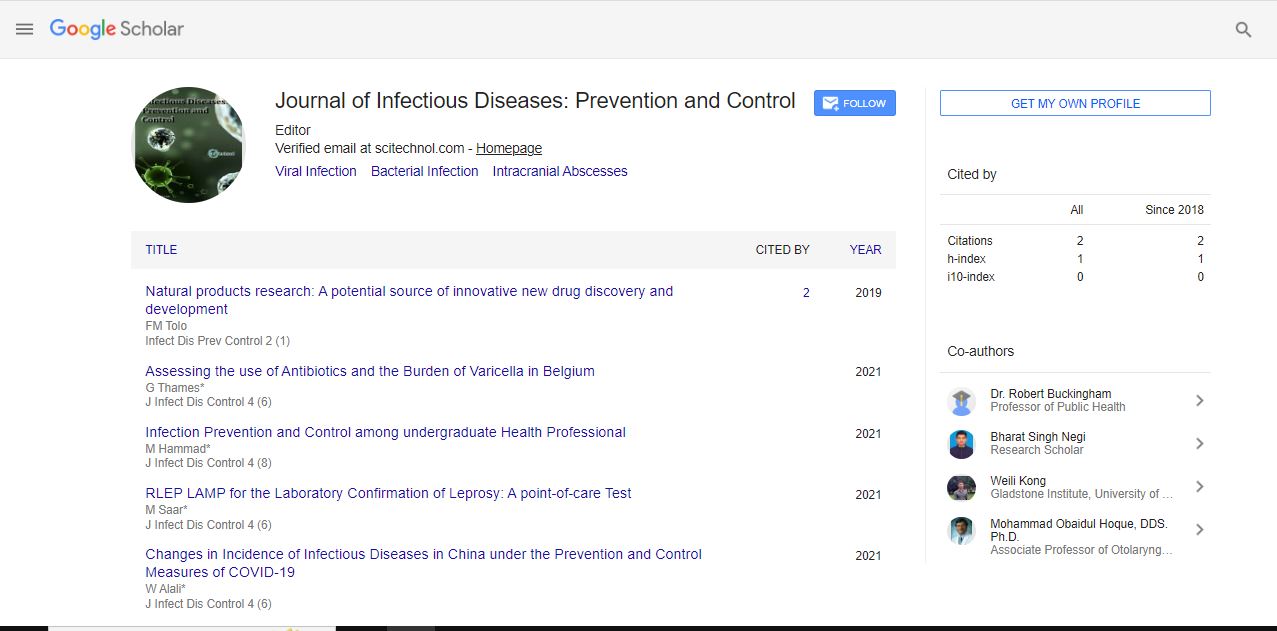Perspective, Vol: 6 Issue: 2
Antiviral Renaissance: The Potential for Viral Treatment Advancements
Ranjit Murugesan*
1Department of Infectious Diseases, Meenakshi Mission Hospital & Research Centre, Madurai, India
*Corresponding Author: Ranjit Murugesan,
Department of Infectious Diseases,
Meenakshi Mission Hospital & Research Centre, Madurai, India
E-mail: RanjitMurugesan2465@gmail.com
Received date: 27 May, 2023, Manuscript No. IDPC-23-105491;
Editor assigned date: 29 May, 2023, Pre QC No. IDPC -23-105491(PQ);
Reviewed date: 15 June, 2023, QC No. IDPC -23-105491;
Revised date: 23 June, 2023, Manuscript No. IDPC -23-105491(R);
Published date: 30 June, 2023, DOI: 10.36648/idpc.5.2.135
Citation: Murugesan R (2023) Antiviral Renaissance: The Potential for Viral Treatment Advancements. Infect Dis Prev Control 6:2.
Abstract
The Antiviral Renaissance marks a pivotal era in medical science, characterized by groundbreaking advancements in the field of viral treatment. This manuscript delves into the multifaceted landscape of antiviral therapies, highlighting recent developments, innovative strategies, and the profound impact they have on combating viral infections. From novel drug discoveries to cutting-edge technologies, this manuscript explores how the Antiviral Renaissance is reshaping our approach to viral treatment, unlocking new avenues for improved patient outcomes and global health security.
Description
The Antiviral Renaissance marks a pivotal era in medical science, characterized by groundbreaking advancements in the field of viral treatment. This manuscript delves into the multifaceted landscape of antiviral therapies, highlighting recent developments, innovative strategies, and the profound impact they have on combating viral infections. From novel drug discoveries to cutting-edge technologies, this manuscript explores how the Antiviral Renaissance is reshaping our approach to viral treatment, unlocking new avenues for improved patient outcomes and global health security.
Understanding antiviral treatments
Antiviral treatments are a class of medications designed to inhibit the replication and spread of viruses within the human body. Unlike vaccines, which primarily focus on preventive measures, antiviral treatments are used to manage viral infections after a person has been exposed or infected. These treatments work by targeting specific components of the virus, such as its enzymes or proteins, to prevent it from multiplying and spreading further.
Development process of antiviral treatments
The development of antiviral treatments is a complex and timeconsuming process that involves rigorous research, testing, and clinical trials. Scientists and pharmaceutical companies invest significant resources into discovering potential antiviral agents. This often begins with laboratory experiments to identify specific compounds that can target the virus effectively.
Once potential compounds are identified, preclinical studies are conducted on cell cultures and animal models to assess their safety, efficacy, and potential side effects. Only compounds that show specific results in these preclinical stages proceed to human clinical trials, which involve different phases to evaluate the treatment's safety and effectiveness in human subjects. Phase I trials focus on safety and dosage, while Phase II trials involve a larger group to further assess safety and efficacy. Phase III trials are large-scale studies that involvethousands of participants and aim to confirm the treatment's benefits and monitor rare side effects. Only after successful completion of these trials can the treatment is submitted for regulatory approval.
Advancements in antiviral treatments
In recent years, there have been notable advancements in antiviral treatments, providing hope for tackling viral infections more effectively. Some of these developments include
mRNA-Based therapies: The success of mRNA-based vaccines, like those developed for COVID-19, has the way for mRNA-based antiviral therapies. These treatments can be rapidly adapted to target specific viral pathogens, accelerating the response time to emerging viral outbreaks.
Broad-spectrum antivirals: Traditional antiviral treatments often target specific viruses. However, broad-spectrum antivirals can combat multiple viruses simultaneously or within the same virus family. Such treatments hold to specific managing viral infections with high mutation rates, like influenza.
Repurposing existing drugs: Drug repurposing involves exploring the potential of existing medications for treating different diseases. This approach has shown encouraging results in identifying drugs that may also possess antiviral properties. Repurposed drugs can expedite the development process and offer immediate solutions during viral outbreaks.
CRISPR-Cas9 technology: CRISPR-based technologies are revolutionizing medicine, including antiviral treatments. Researchers are exploring the use of CRISPR-Cas9 to directly target and edit viral genomes, rendering them inactive and incapable of causing infection.
Monoclonal antibodies: Monoclonal antibodies have been used successfully to treat certain viral infections, and ongoing research aims to develop more potent and targeted antibodies for a wider range of viruses.
Challenges and future prospects
Despite the specific advancements, there are challenges that need to be addressed to the potential of antiviral treatments. These challenges include
Viral resistance: As with antibiotics, viruses can develop resistance to antiviral treatments over time. Continued research and vigilance are essential to stay ahead of rapidly mutating viruses and develop novel therapies that can overcome resistance.
Access and affordability: Ensuring equitable access to antiviral treatments across the globe remains a significant challenge. High costs and logistical issues often restrict access to effective treatments in resource-limited regions, perpetuating health disparities.
Regulatory hurdles: The regulatory approval process for antiviral treatments is rigorous, and there is a need for streamlined mechanisms to expedite the approval of life-saving treatments during emergencies.
Emerging viruses: The emergence of new and unknown viruses remains a constant threat. Antiviral research must be adaptable to address previously unseen viral pathogens.
 Spanish
Spanish  Chinese
Chinese  Russian
Russian  German
German  French
French  Japanese
Japanese  Portuguese
Portuguese  Hindi
Hindi 